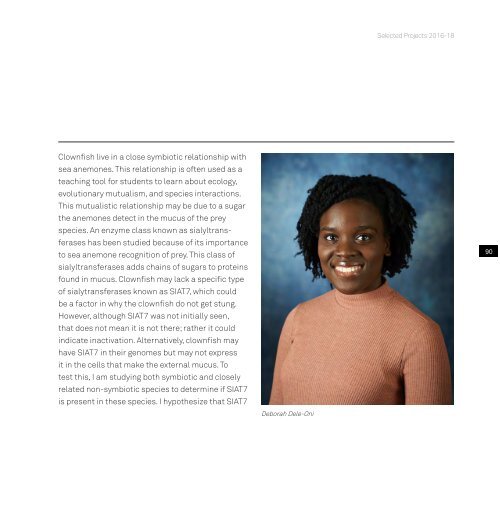Undergrad_Book_16-18_Pge_View_Print_no print marks_compressed
You also want an ePaper? Increase the reach of your titles
YUMPU automatically turns print PDFs into web optimized ePapers that Google loves.
Selected Projects 20<strong>16</strong>-<strong>18</strong><br />
Clownfish live in a close symbiotic relationship with<br />
sea anemones. This relationship is often used as a<br />
teaching tool for students to learn about ecology,<br />
evolutionary mutualism, and species interactions.<br />
This mutualistic relationship may be due to a sugar<br />
the anemones detect in the mucus of the prey<br />
species. An enzyme class k<strong>no</strong>wn as sialyltransferases<br />
has been studied because of its importance<br />
to sea anemone recognition of prey. This class of<br />
sialyltransferases adds chains of sugars to proteins<br />
found in mucus. Clownfish may lack a specific type<br />
of sialytransferases k<strong>no</strong>wn as SIAT7, which could<br />
be a factor in why the clownfish do <strong>no</strong>t get stung.<br />
However, although SIAT7 was <strong>no</strong>t initially seen,<br />
that does <strong>no</strong>t mean it is <strong>no</strong>t there; rather it could<br />
indicate inactivation. Alternatively, clownfish may<br />
have SIAT7 in their ge<strong>no</strong>mes but may <strong>no</strong>t express<br />
it in the cells that make the external mucus. To<br />
test this, I am studying both symbiotic and closely<br />
related <strong>no</strong>n-symbiotic species to determine if SIAT7<br />
is present in these species. I hypothesize that SIAT7<br />
Deborah Dele-Oni<br />
90



